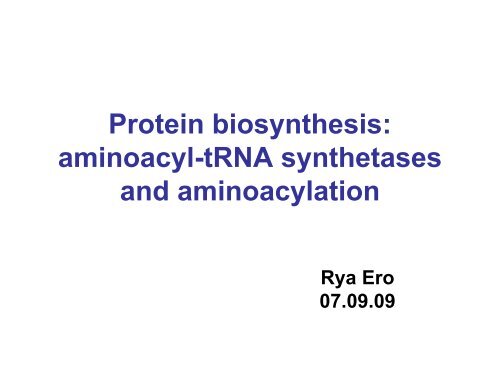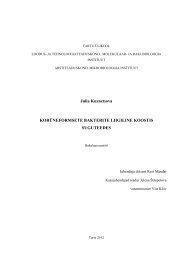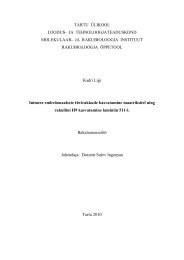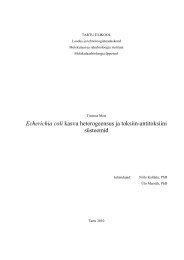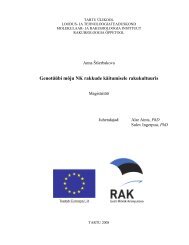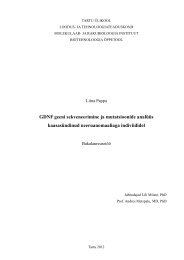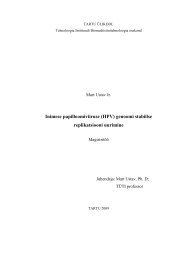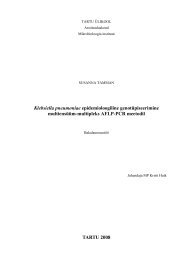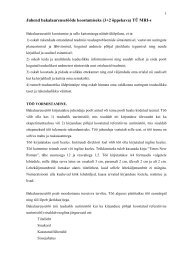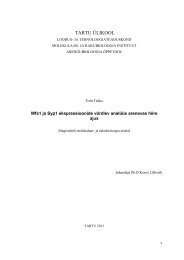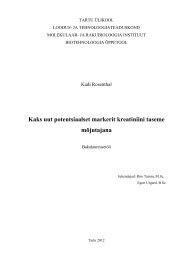Protein biosynthesis: aminoacyl-tRNA synthetases and aminoacylation
Protein biosynthesis: aminoacyl-tRNA synthetases and aminoacylation
Protein biosynthesis: aminoacyl-tRNA synthetases and aminoacylation
You also want an ePaper? Increase the reach of your titles
YUMPU automatically turns print PDFs into web optimized ePapers that Google loves.
<strong>Protein</strong> <strong>biosynthesis</strong>:<br />
<strong>aminoacyl</strong>-<strong>tRNA</strong> <strong>synthetases</strong><br />
<strong>and</strong> <strong>aminoacyl</strong>ation<br />
Rya Ero<br />
07.09.09
Aminoacyl-<strong>tRNA</strong> <strong>synthetases</strong><br />
(AaRS)<br />
• charge <strong>tRNA</strong>s with amino acids (establish the<br />
link between nucleic <strong>and</strong> amino acids)<br />
• divided into two unrelated classes by based on<br />
structural <strong>and</strong> biochemical properties<br />
• highly specific - join 1 type of amino acid to all its<br />
corresponding (cognate) <strong>tRNA</strong>s<br />
• nomenclature:<br />
Nomenclature of <strong>tRNA</strong> <strong>synthetases</strong> <strong>and</strong> charged <strong>tRNA</strong>s.<br />
amino<br />
acid<br />
serine<br />
leucine<br />
cognate<br />
<strong>tRNA</strong><br />
<strong>tRNA</strong> Ser<br />
<strong>tRNA</strong> Leu<br />
<strong>tRNA</strong> Leu<br />
UUA<br />
cognate <strong>aminoacyl</strong> <strong>tRNA</strong><br />
synthetase<br />
seryl-<strong>tRNA</strong> synthetase<br />
leucyl-<strong>tRNA</strong> synthetase<br />
<strong>aminoacyl</strong> <strong>tRNA</strong><br />
(charged <strong>tRNA</strong>)<br />
seryl- <strong>tRNA</strong> Ser<br />
leucyl- <strong>tRNA</strong> Leu<br />
leucyl- <strong>tRNA</strong> Leu<br />
UUA
Comparison of class I <strong>and</strong> class II<br />
AaRSs<br />
Class I<br />
Class II<br />
Structure of the enzyme<br />
active site<br />
Interaction with the <strong>tRNA</strong><br />
Orientation of the bound<br />
<strong>tRNA</strong><br />
Amino acid attachment<br />
Enzymes for ...<br />
Parallel β-sheet<br />
(Rossman fold)<br />
Minor groove of the<br />
acceptor stem<br />
variable loop faces away<br />
from the enzyme<br />
To the 2′-OH of the<br />
terminal nucleotide of<br />
<strong>tRNA</strong><br />
Arg, Cys, Gln, Glu, Ile,<br />
Leu, Lys1, Met, Trp, Tyr,<br />
Val<br />
Antiparallel β-sheet<br />
Major groove of the<br />
acceptor stem<br />
variable loop faces the<br />
enzyme<br />
To the 3′-OH of the terminal<br />
nucleotide of the <strong>tRNA</strong><br />
Ala, Asn, Asp, Gly, His,<br />
Lys2, Phe, Pro, Thr, Ser
Classification <strong>and</strong> subunit structure of AaRSs in<br />
E. coli<br />
Class I<br />
Class II<br />
Arg (α) Ala (α 4<br />
)<br />
Cys (α) Asn (α 2<br />
)<br />
Gln (α) Asp (α 2<br />
)<br />
Glu (α) Gly (α 2<br />
β 2<br />
)<br />
IIe (α) His (α 2<br />
)<br />
Leu (α) Lys (α 2<br />
)<br />
Met (α) Phe (α 2<br />
β 2<br />
)<br />
Trp (α 2<br />
) Ser (α 2<br />
)<br />
Tyr (α 2<br />
) Pro (α 2<br />
)<br />
Val (α) Thr(α 2<br />
)
Evolution <strong>and</strong> sub-groups of AaRS
Class I active site (Rossman fold - 5 parallel β<br />
str<strong>and</strong>s connected by α helices), HIGH <strong>and</strong><br />
KMSKS signature sequences, extended<br />
conformation of bound ATP
Class II active site, 3 conserved motifs:<br />
• motif 1 - binding ATP (bent conformation) (α-helix)<br />
• motif 2 - amino acid binding (β-sheet)<br />
• motif 3 - dimerization
Comparison of class I <strong>and</strong> class II active sites
Recognition of <strong>tRNA</strong>s by AspRS (class II) <strong>and</strong> ArgRS<br />
(class I), shown as outlines. The <strong>tRNA</strong>Asp shown will<br />
bind to either. Sites on the opposite sides of <strong>tRNA</strong><br />
make contacts with the two AaRSs (blue balls -<br />
contacts with AspRS, yellow balls - with ArgRS).
Class I aaRSs interact with the 5’ nucleotides of the<br />
acceptor stem <strong>and</strong> class II aaRSs with the 3’<br />
nucleotides.<br />
The CCA arm of <strong>tRNA</strong> adopts different conformations<br />
in complexes with the class I <strong>and</strong> class II AaRSs.
The structure of the complex between threonyl-<strong>tRNA</strong><br />
synthetase (class II) <strong>and</strong> <strong>tRNA</strong>Thr reveals that the<br />
synthetase binds to both the acceptor stem <strong>and</strong> the<br />
anticodon loop of <strong>tRNA</strong>.
Glutaminyl-<strong>tRNA</strong> synthetase (class I) <strong>tRNA</strong>Gln<br />
complex reveals that the synthetase interacts with<br />
base pair G10:C25 in addition to the acceptor step<br />
<strong>and</strong> anticodon loop.
LysRS of most eukaryotes <strong>and</strong> bacteria is a class II<br />
AaRS, but in archaea class I AaRS (blue – highly<br />
conserved region, red – less conserved region).<br />
Recognice same regions of <strong>tRNA</strong>, <strong>aminoacyl</strong>ation<br />
mechanism differs.
Other functions of AaRS<br />
• nuclear proofreading of <strong>tRNA</strong>s prior to their<br />
export to cytoplasm (<strong>tRNA</strong> <strong>aminoacyl</strong>ation<br />
takes place in cucleus, AaRSs must be<br />
imported from cytoplasma)<br />
• involved in transcriptional <strong>and</strong> translational<br />
control of protein <strong>biosynthesis</strong><br />
• <strong>aminoacyl</strong>ation of <strong>tRNA</strong>-like structures (tmRNA<br />
a.k.a. 10SaRNA )
• inhibiors of AaRSs can be used as antibiotics<br />
• mupirocin inhibits IleRS of gram-positive (S.<br />
aureus) <strong>and</strong> gram-negative bacteria (H.<br />
influenzae)
In eukaryotes some AaRSs form complexes with<br />
other proteins, function not known
<strong>tRNA</strong>
<strong>tRNA</strong> identity elements<br />
• signals in <strong>tRNA</strong> required by AaRSs for correct<br />
<strong>aminoacyl</strong>ation, “second genetic code”<br />
• each AaRS must be able to distinguish the correct<br />
(cognate) <strong>tRNA</strong> from all the others<br />
• isoacceptor <strong>tRNA</strong>s have mostly the same set of<br />
identity determinants<br />
• swapping identity elements between <strong>tRNA</strong>s can<br />
cause the AaRS to add amino acid to the wrong<br />
<strong>tRNA</strong><br />
• identity of <strong>tRNA</strong> is determined by its primary,<br />
secondary <strong>and</strong> tertiary structure
Sequence elements:<br />
Mostly non-modified nucleosides (except E. coli<br />
<strong>tRNA</strong>Ile, <strong>tRNA</strong>Glu <strong>and</strong> <strong>tRNA</strong>Lys)<br />
• N73 discriminator position (except E. coli<br />
<strong>tRNA</strong>Thr <strong>and</strong> <strong>tRNA</strong>Glu)<br />
• anticodon nucleosides (except E. coli <strong>tRNA</strong>Ala,<br />
<strong>tRNA</strong>Ser <strong>and</strong> <strong>tRNA</strong>Leu)<br />
• first base pairs in acceptor stem (mostly N1:N72<br />
<strong>and</strong> N2:N71)<br />
Nucleosides in <strong>tRNA</strong> core are infrequently used<br />
as identity determinants
G3<br />
<strong>tRNA</strong> Ala<br />
U70<br />
G20<br />
A73<br />
G34 A36<br />
A35<br />
<strong>tRNA</strong> Phe<br />
G1<br />
G2<br />
AU3<br />
G73<br />
C72<br />
C71<br />
UA70<br />
C11<br />
G24<br />
G35 A36<br />
U37<br />
<strong>tRNA</strong><br />
fMet<br />
<strong>tRNA</strong> Ser
Structural elements:<br />
identity elements may also act indirectly through<br />
changing the conformation of <strong>tRNA</strong> recognized by<br />
AaRS<br />
• lengths of variable <strong>and</strong> D loops are important for E.<br />
coli <strong>tRNA</strong>Gln, <strong>tRNA</strong>Ala <strong>and</strong> yeast <strong>tRNA</strong>Phe.<br />
• long extra arm in <strong>tRNA</strong>Ser is important for<br />
recognition<br />
• major recognition element for E. coli AlaRS is<br />
G3:U70 wobble base pair in <strong>tRNA</strong>Ala. Not certain<br />
whether AlaRS recognices the specific chamical<br />
groups or the acceptor stem conformation induced<br />
by this base pair.
In case of <strong>tRNA</strong>Ala a<br />
single base pair (G3-<br />
U70) in the right<br />
context of the<br />
acceptor stem is<br />
necessary <strong>and</strong><br />
sufficient for<br />
recognition by AlaRS<br />
Microhelix recognized by AlaRS. A stem-loop<br />
containing just 24 nt corresponding to the <strong>tRNA</strong><br />
acceptor stem is <strong>aminoacyl</strong>ated by AlaRS.
• Anti-determinants: negative signals that keep<br />
<strong>tRNA</strong>s from <strong>aminoacyl</strong>ation by non-cognate<br />
AaRSs. Include modified nucleosides <strong>and</strong><br />
structural elements. May be located in different<br />
regions of <strong>tRNA</strong><br />
• Permissive elements: not directly involved in<br />
determining the identity of <strong>tRNA</strong>, form a context<br />
for optimal recognition of <strong>tRNA</strong> identity elements<br />
by AaRSs<br />
Different identity elements may have additive,<br />
cooperative, anti-cooperative, or independent<br />
effects
Conserved nucleosides (left) <strong>and</strong> identity<br />
elements (right) in E. coli <strong>tRNA</strong>s
• identity elements mostly clustered in acceptor<br />
stem <strong>and</strong> anticodon region<br />
• these two regions come into close contact with<br />
AaRSs<br />
• aaRSs mostly contact with <strong>tRNA</strong> hydrogen<br />
bonds are formed beween identity nucleosides<br />
in <strong>tRNA</strong> <strong>and</strong> amino acids in AaRSs<br />
• stronger <strong>and</strong> weaker identity elements exist
Aminoacylation reaction<br />
• there is a different AaRS for each amino acid (20<br />
in all) in most cells<br />
• recognition of amino acid <strong>and</strong> <strong>tRNA</strong> varies<br />
among AaRSs<br />
• all AaRSs catalyze the same 2-step ATPdependent<br />
reaction<br />
(1) aaRS + ATP:Mg2+ + aa ↔ aaRS:aa:AMP + PPi :Mg2+<br />
(2) aaRS:aa:AMP + <strong>tRNA</strong> ↔ aaRS + aa-<strong>tRNA</strong> + AMP
Step 1 – activation of amino acid<br />
aa + ATP + AaRS ↔ AaRS·aa-AMP + PPi<br />
carboxyl oxygen of amino acid reacts<br />
with α-phosphate of ATP,<br />
<strong>aminoacyl</strong>adenylate (high energy<br />
intermediate) is formed <strong>and</strong> PPi<br />
released<br />
Step 2 – A76 of uncharged <strong>tRNA</strong> reacts<br />
with <strong>aminoacyl</strong>adenylate<br />
AaRS·aa-AMP + <strong>tRNA</strong> ↔ AaRS + aa<strong>tRNA</strong><br />
+AMP<br />
nucleophilic attac of 2’ or 3’ hydroxyl<br />
group of <strong>tRNA</strong> 3’-terminal adenosine to<br />
carboxyl grooup of <strong>aminoacyl</strong>adenylate,<br />
ester bond is formed between <strong>tRNA</strong><br />
<strong>and</strong> amino acid
The result of <strong>aminoacyl</strong>ation by a class II AaRS, the<br />
amino acid being attached via its -COOH group to<br />
the 3′-OH of the terminal nucleotide of the <strong>tRNA</strong>. A<br />
class I AaRS attaches the amino acid to the 2′-OH<br />
group.
adenosine P P P +<br />
ATP<br />
Step 1<br />
O<br />
C<br />
O<br />
P<br />
P<br />
CH<br />
R<br />
+<br />
NH3<br />
amino acid<br />
O<br />
C C A<br />
+<br />
O C CH NH<br />
P P 3<br />
OH<br />
R<br />
2-<strong>aminoacyl</strong> <strong>tRNA</strong><br />
adenosine P<br />
O<br />
+<br />
C CH NH3<br />
~ O R <strong>aminoacyl</strong> adenylate<br />
or<br />
Step 2<br />
C C A<br />
P<br />
P<br />
OH<br />
OH<br />
C C A<br />
P<br />
P<br />
O C CH<br />
+<br />
NH3<br />
R<br />
OH<br />
O<br />
3-<strong>aminoacyl</strong> <strong>tRNA</strong>
• some class I AaRS (GlnRS, GluRS, ArgRS <strong>and</strong> class<br />
I LysRS) require prior binding of <strong>tRNA</strong> for step 1<br />
• binding of <strong>tRNA</strong> occurs in presence of polyamine or<br />
divalent cation (Mg2+)<br />
• hydrolysis of the pyrophosphate to inorganic<br />
phosphate (by pyrophosphatase) drives the reaction<br />
forward<br />
• class I AaRSs join the aa to the 2'-OH, subsequent<br />
transesterification reaction shifts the amino acid to<br />
the 3' position<br />
• the amino acid-<strong>tRNA</strong> bond is of ‘higher energy’ than<br />
the peptide bond which helps the ribosome<br />
transpeptidate
Structure of the large fragment of ThrRS reveals<br />
that the amino acid-binding site includes a zinc ion<br />
that coordinates threonine through its amino <strong>and</strong><br />
hydroxyl groups.
Active site structure of ThrRS, recognices 3’<br />
CCA sequence, which enters a “pocket”
Accuracy of <strong>aminoacyl</strong>ation<br />
Accurate amino acid <strong>and</strong> <strong>tRNA</strong> recognition by<br />
AaRSs is crucial for protein synthesis<br />
Recognition of <strong>tRNA</strong>s by the synthetase is<br />
controlled at two steps:<br />
• AaRS has a greater affinity for its cognate <strong>tRNA</strong><br />
• <strong>aminoacyl</strong>ation of the incorrect <strong>tRNA</strong> is very slow<br />
Selection based on the differences of the rates is<br />
known as kinetic proofreading
AaRSs use chemical properties, size <strong>and</strong> shape<br />
to distinguish between amino acids<br />
• In case of HisRS, ProRS <strong>and</strong> LysRS only<br />
binding of the correct amino acid induces<br />
conformational change in AaRSs required for<br />
<strong>aminoacyl</strong>ation reaction to occur<br />
• moving parts are KMSKS sequence (class I) or<br />
loop of motif 2 (class II)
• AaRS have difficulties discriminating some<br />
amino acids (for example Ile <strong>and</strong> Val are similar)<br />
• AaRS should make many mistakes(Linus<br />
Pauling, 1958)<br />
ValRS incorporates Ile instead of Val into<br />
proteins only with the frequency of 1:3000
Absolute accuracy of <strong>aminoacyl</strong>ation cannot be<br />
achieved<br />
• <strong>tRNA</strong>Lys is <strong>aminoacyl</strong>ated by LysRS with:<br />
Arg 1:1600<br />
Thr 1:16000<br />
Met 1:32000<br />
Leu 1:132000<br />
Cys 1:256000<br />
Ser 1:750000<br />
The frequency of errors in <strong>aminoacyl</strong>ation is less<br />
than 10 -5
<strong>tRNA</strong> editing<br />
Some AaRSs remove their own coupling errors<br />
through hydrolytic editing<br />
• Pre-transfer editing – non-cognate<br />
<strong>aminoacyl</strong>adenylate is hydrolyzed befor its<br />
transfer to <strong>tRNA</strong><br />
• Post-transfer editing – ester bond between<br />
amino acid <strong>and</strong> non-cognate <strong>tRNA</strong> is hydrolyzed
• some AaRS (IleRS, ValRS, LeuRS <strong>and</strong> ThrRS)<br />
have editing sites in addition to acylation sites<br />
• these two sites function as a a double sieve to<br />
ensure a very high fidelity<br />
• wrong amino acid cannot bind to active site <strong>and</strong><br />
correct amino acid is rejected by the editing site<br />
• hydrolysis of correct product is slow <strong>and</strong> hydrolysis<br />
of the “wrong” product is quick<br />
• in case of IleRS 80% of editing is pre-transfer, in<br />
case of ValRS <strong>and</strong> LeuRS mostly post-transfer<br />
editing (double sieve)
The flexible CCA arm of an <strong>aminoacyl</strong>-<strong>tRNA</strong> can move<br />
the amino acid between the activation site <strong>and</strong> the<br />
editing site. If the amino acid fits well into the editing<br />
site, the amino acid is removed by hydrolysis.
Pyrococcus horikoshii LeuRS-<strong>tRNA</strong>Leu complex
• Val is rejected based on<br />
chemical properties (Zn ion<br />
in active site)<br />
• Ser is rejected based on<br />
size<br />
Activation <strong>and</strong> editing sites in threonyl-<strong>tRNA</strong><br />
synthetase (class II)
Unusual <strong>aminoacyl</strong>ation<br />
mechanisms<br />
Exceptions to the one-to-one rule (Francis<br />
Crick 1958) that there is a specific AaRS for<br />
each amino acid (there should be 20 different<br />
AaRS in every organism)<br />
1. Two different AaRSs may be expressed for<br />
single amino acid:<br />
• two LysRS genes in E. coli – lysU <strong>and</strong> lysS<br />
• two ThrRS <strong>and</strong> TyrRS in B. Subtilis
2. When GlnRS is missing (B. subtilis)<br />
then Gln-<strong>tRNA</strong>Gln is formed in 2 steps:<br />
ND-<br />
GluRS<br />
Glu + <strong>tRNA</strong> Gln + ATP Glu-<strong>tRNA</strong> Gln + AMP + PPi<br />
AdT<br />
Gln + Glu-<strong>tRNA</strong> Gln + ATP Gln-<strong>tRNA</strong> Gln + ADP + Pi + Glu<br />
D-GluRS Glu-<strong>tRNA</strong> Glu<br />
ND-GluRS Glu-<strong>tRNA</strong> Glu <strong>and</strong> Glu-<strong>tRNA</strong> Gln<br />
AdT is an amidotransferase<br />
EF-Tu does not bind Glu-<strong>tRNA</strong>Gln, avoiding<br />
misincorporation of Glu instead of Gln into proteins
RS<br />
D-GluRS: C36 – Arg358 discriminates <strong>tRNA</strong> Glu <strong>and</strong> <strong>tRNA</strong> Gln<br />
ND-GluRS: Glu instead of Arg cannot discriminate <strong>tRNA</strong> Glu from <strong>tRNA</strong> Gln
3. When AsnRS is missing (in T. thermophilus<br />
<strong>and</strong> D. radiodurans in addition to the lack of<br />
GlnRS) then Asn-<strong>tRNA</strong>Asn is formed in 2 seps:<br />
ND-<br />
AspRS<br />
<strong>tRNA</strong> Asn Asp-<strong>tRNA</strong> Asn Asn-<strong>tRNA</strong> Asn<br />
AdT<br />
D-AspRS Asp-<strong>tRNA</strong> Asp<br />
ND-AspRS Asp-<strong>tRNA</strong> Asp<br />
<strong>and</strong> Asp-<strong>tRNA</strong> Asn<br />
Amidotransferase (AdT) is same for both Gln<strong>tRNA</strong>Gln<br />
<strong>and</strong> Asp-<strong>tRNA</strong>Asp synthesis, amido<br />
group donor is also glutamine
4. Some thermophilic archaea (Methanococcus<br />
jannaschii) lack cysS gene encoding for<br />
CysRS<br />
Possess unique ProCysRS synthetase able to<br />
generate both Pro-<strong>tRNA</strong>Pro <strong>and</strong> Cys-<strong>tRNA</strong>Cys
5. Selenosysteine - the 21-st amino acid <strong>and</strong><br />
Sec-<strong>tRNA</strong>Sec formation<br />
<strong>tRNA</strong> Sec SerRS<br />
Ser-<strong>tRNA</strong> Sec selA<br />
Sec-<strong>tRNA</strong> Sec<br />
selD
•<strong>aminoacyl</strong>ation of <strong>tRNA</strong>Sec by SerRS (Ser-<strong>tRNA</strong>Sec)<br />
•selenocysteine synthase SelA converts to aminoacryl<strong>tRNA</strong>Sec<br />
•SelD adds selenide to aminoacryl group <strong>and</strong> Sec<strong>tRNA</strong>Sec<br />
is formed
6. Initiator fMet<strong>tRNA</strong><br />
is<br />
formylated Met<strong>tRNA</strong><br />
Synthesized by<br />
methionyl-<strong>tRNA</strong><br />
formyltransferase<br />
(MTF)
MTF
Additional reading:<br />
1. TiBS, July 2000, vol 25 “The adaptor<br />
hypothesis revisited”<br />
2. TiBS, June 1997, vol 22 “Structural <strong>and</strong><br />
functional considerations of the <strong>aminoacyl</strong>ation<br />
reaction”<br />
3. BioEssays, Oct. 1993 No 10 “Aminoacyl-<strong>tRNA</strong><br />
synthetase family: Modules at work”<br />
4. Current opinion in structural biology, Feb. 2000<br />
vol10 No1 “The many routes of bacterial <strong>tRNA</strong>s<br />
after <strong>aminoacyl</strong>ation”


